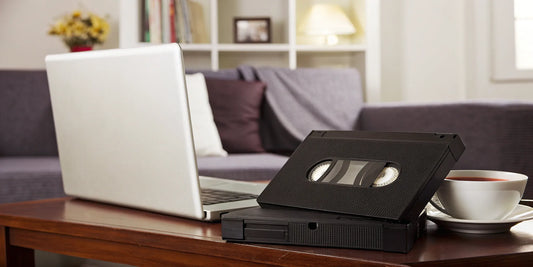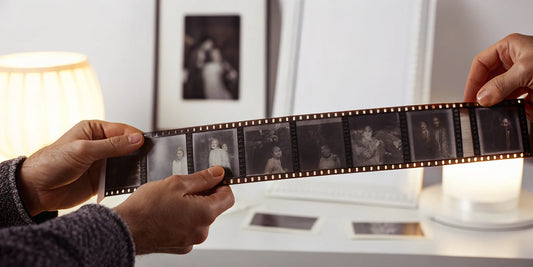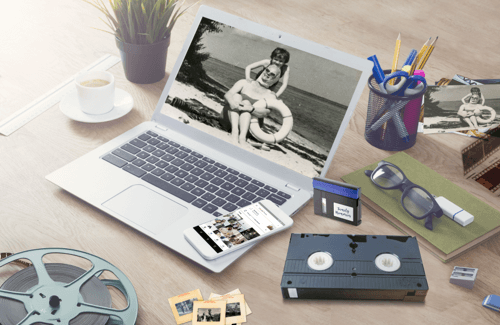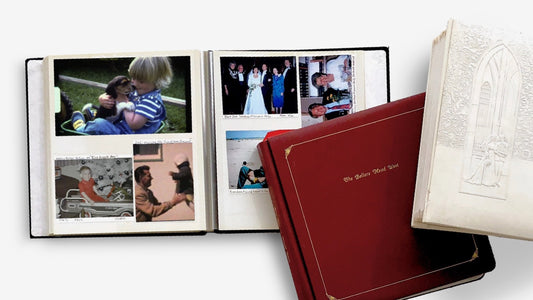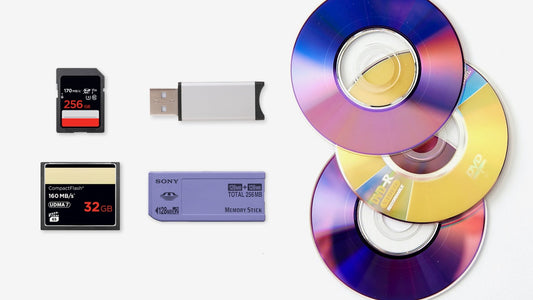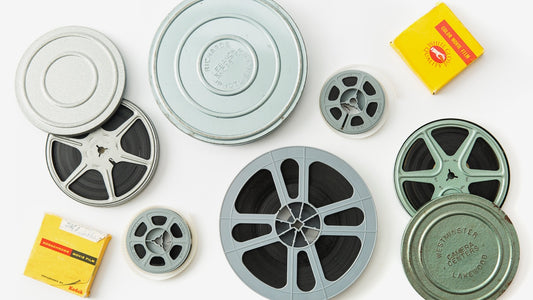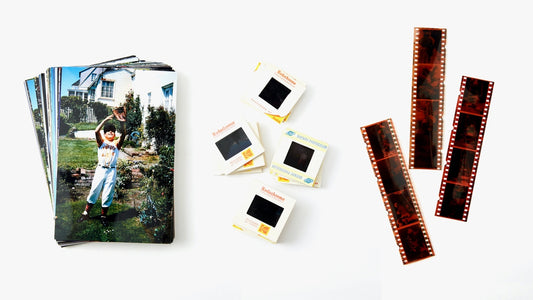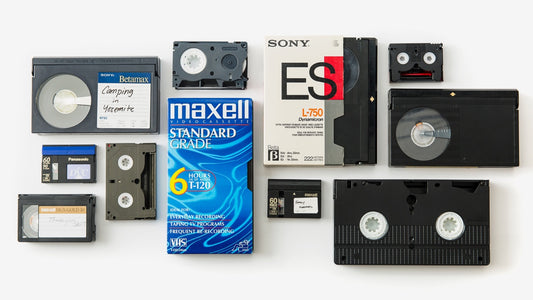Your family photos are more than just paper and ink; they're irreplaceable pieces of your history. But physical prints are surprisingly fragile. They face constant threats from fading, discoloration, and accidental damage like spills or tears. The thought of losing these memories is heartbreaking. Thankfully, you can protect them when you scan photos to digital. This process creates lasting, high-quality copies, effectively future-proofing your family’s legacy. In this guide, we’ll explore the best ways to digitize your collection, ensuring those priceless snapshots are preserved and ready to be shared for generations.
Key Takeaways
- Preserve and Share with Ease: Converting your physical photos to digital safeguards them against time and damage, making it simple to share those cherished memories with family and friends.
- Choose Your Scanning Adventure: Decide between professional services, like YesVideo for specialized tasks such as album scanning, or a hands-on DIY approach based on your specific needs, available time, and how tech-savvy you feel.
- Organize and Protect Your Digital Treasures: After scanning, ensure your digital photos look their best, create a straightforward organization system, and implement a solid backup strategy to keep your memories secure and accessible.
Why Scan Your Photos to Digital?
Let's be honest, those boxes of old photos tucked away in the attic or basement aren't doing anyone much good. While they hold precious memories, physical photographs are vulnerable. They can fade, get discolored, or suffer damage from moisture, pests, or just the passage of time. Digitizing your photos is like giving them a new lease on life, ensuring those priceless family moments are preserved for generations to come. Think about it – instead of pictures degrading in a shoebox, you can have them safely stored and easily accessible.
Once your photos are digital, sharing them becomes incredibly simple. Imagine easily sending that hilarious baby picture of your sibling for their birthday, or creating a beautiful digital slideshow for a family reunion. No more worrying about the original getting lost or damaged in the mail! Plus, everyone in the family can have their own copies to enjoy. It’s a fantastic way to commemorate your past and keep those connections strong.
Beyond just preservation and sharing, digitizing opens up a world of possibilities for enjoying your photos. You can organize them, create custom photo books, or even use them in digital art projects. And if you're concerned about getting the best quality, you have options. While you can certainly digitize photos at home, professional services like YesVideo's photo transfer can handle the process for you, ensuring high-quality scans without you needing to buy equipment or spend hours at a scanner. It’s all about making those memories easy to access, share, and cherish.
The Best Photo Scanning Services Reviewed
When you're ready to bring your precious photo memories into the digital age, choosing the right service can feel like a big decision. After all, these aren't just pieces of paper; they're irreplaceable moments, snapshots of your family's history and your own personal journey. You want to entrust them to a company that understands their value and will handle them with the utmost care.
Finding the perfect match involves a bit of homework. Think about what’s most important for your specific collection. Do you have thousands of loose photos that need efficient processing, or a few delicate, antique albums that require a special touch, like album scanning? Are you looking for basic digitization, or do you need options for color correction and restoration? Consider the resolution options offered – higher resolution means better quality, especially if you plan to print enlargements later. Don't forget to check turnaround times, especially if you have a deadline, like an upcoming anniversary or family reunion. Reading customer reviews can also provide invaluable insights into the experiences of others as you explore different photo scanning services.
It's completely normal to feel a little anxious about sending your photos away. These services understand that. Reputable companies have established processes to track and care for your items from the moment they receive them until they're safely returned, along with your new digital copies. The peace of mind that comes from knowing your memories are preserved and easily shareable for generations is truly priceless. Below, we’ll explore some of the leading photo scanning services, highlighting what makes each one stand out, so you can make an informed choice that feels right for you and your cherished photos.
YesVideo: A Closer Look
If you have photo albums you’d love to digitize without taking them apart, YesVideo is a wonderful choice. They offer a unique, touchless photo album scanning service, which means your albums stay intact while every page is carefully digitized. This is perfect for preserving the way you originally curated your memories, from handwritten captions to the order of the photos. They handle your memories with care, ensuring that the digital copies reflect the heart and soul you poured into creating those albums. It’s a thoughtful approach for anyone who values the album as much as the individual photos, and a key part of how they help you preserve your memories.
Legacybox: A Closer Look
Legacybox has made a name for itself by helping over a million customers preserve their family memories. They specialize in converting not just your printed photos, but also slides and negatives into digital formats. So, if you have a mix of media tucked away in boxes, Legacybox can handle it all. Their process is designed to be straightforward for you – you send them your items, and they do the careful work of digitizing them. It’s a reliable option if you're looking for a service with a strong track record and a focus on making photo preservation easy for a wide range of analog media.
ScanMyPhotos: A Closer Look
Do you have boxes upon boxes of photos? If the sheer volume feels overwhelming, ScanMyPhotos could be your go-to. They are well-known for their bulk photo scanning capabilities, making them an efficient choice for digitizing hundreds, or even thousands, of prints. This service is particularly helpful if your main goal is to get a large collection converted quickly without sacrificing quality. They've streamlined the process for large orders, so you can finally tackle that mountain of memories and bring them into an easily shareable digital format. It’s a practical solution for those big archiving projects where speed and volume are key considerations.
Service Features and Guarantee
When you're choosing a service, it's about more than just scanning; it's about trust and the final product. YesVideo stands out by hand-processing every order in the USA, ensuring a personal touch for your irreplaceable memories. This is especially important for delicate items like photo albums, which they can digitize without taking them apart. Other services offer different assurances. ScanMyPhotos.com, for instance, promises you'll be 100% happy or they'll redo the work. Retail options like CVS and Walgreens Photo offer the convenience of starting your order online or at an in-store kiosk, and they return your memories on a DVD, Blu-ray, or USB drive. Meanwhile, FotoBridge, which was named 'Best Photo Digitizer' by New York Magazine, focuses on turning your printed photos into high-quality digital files, offering various packages to suit different collection sizes.
Pricing and Payment Options
Pricing structures can vary quite a bit, so it’s smart to know what to expect. Services like CVS and Walgreens have straightforward starting prices, with photo digitization beginning at $29.99. For those with huge collections, ScanMyPhotos.com advertises very low prices, with scans for as little as 9 cents each, making it an attractive option for bulk orders. FotoBridge uses a tiered system, where the price per photo decreases as the quantity increases; for example, 250 photos cost $69.95, while 2,000 photos are $499.95. YesVideo offers a clear, per-item pricing model, so you know exactly what you're paying for. A standard photo print transfer has a set price per image, which means you can tailor your order to your exact needs and budget without any guesswork.
Walmart Photo (Capture): A Closer Look
Many of us trust Walmart for everyday needs, and they also offer a reliable way to digitize your memories through their partnership with Capture. This service provides a safe option for converting your home movies and photos into digital formats. Knowing that a familiar name is behind the process can offer peace of mind, especially when you're sending off irreplaceable items. They aim to safeguard your memories while transforming them into a more modern, accessible format. It’s a convenient choice if you prefer working with established brands for services like these and want a straightforward way to handle your digitization needs.
Memories Renewed: A Closer Look
Memories Renewed is dedicated to helping families preserve their legacies through a variety of digitization services. Beyond standard photo scanning, they also offer video transfer and even photo restoration, which is fantastic if some of your older photos have seen better days. Their commitment to quality shines through in their careful handling and processing of your cherished items. If you're looking for a service that can handle different types of media and potentially restore some of your more delicate or damaged photos, they are definitely worth considering for a comprehensive approach to memory preservation.
GoPhoto: A Closer Look
For those seeking flexibility in their photo scanning project, GoPhoto offers a good range of services. They can handle bulk scanning if you have a large collection, and they provide various digital format options to suit whatever your end-use might be – whether it's for archiving, sharing online, or creating photo gifts. Their combination of quality output and adaptable service makes them a popular choice. If you have specific needs regarding how your photos are scanned or the format you want them in, GoPhoto’s flexibility could be a great match for your project, allowing you to tailor the service to your requirements.
Scan Cafe: A Closer Look
If attention to detail and high-quality results are at the top of your list, Scan Cafe is a strong contender. They provide a comprehensive photo scanning service that not only digitizes your images but also includes options for restoration. This is particularly valuable for older photos that might be faded, torn, or discolored. Their meticulous approach ensures that your photos are preserved beautifully in their new digital form, capturing the essence of the original moments. They are a great option if you want to ensure each image receives careful treatment for the best possible digital conversion, especially for photos needing extra care.
FotoBridge: A Closer Look
FotoBridge is a service that focuses on turning your loose printed photos into organized digital files. They offer a straightforward process designed around different package sizes, which is great if you have a general idea of how many photos you need to scan. This makes them a solid choice for those who appreciate clear, upfront options and want to tackle a box of photos without getting bogged down in too many decisions. Their goal is to provide a complete service, from the initial scan to enhancing your images and delivering them back to you. This all-in-one approach can be very appealing if you're looking for a service to handle the entire process from start to finish.
Scanning Process and Quality
When you send your photos to FotoBridge, they are scanned at a default resolution of 300 DPI (dots per inch). This quality is perfectly suitable for most everyday uses, like sharing your photos on social media, viewing them on a screen, or making standard-sized prints. If you have plans for larger prints or want the highest possible quality for archival purposes, you can pay an additional fee to have your photos scanned at 600 DPI. This flexibility allows you to choose the level of detail that best fits your needs and budget, ensuring you get the right quality for how you plan to use your digital memories.
Pricing and Add-Ons
FotoBridge structures its service around different package sizes, allowing you to select the one that best matches the size of your photo collection. This package-based model provides clarity on costs from the outset. They aim to offer a comprehensive experience, with options to enhance your photos and various delivery methods to suit your preferences. This makes it easy to find a solution that fits your specific project, whether you have a small batch of cherished photos or a massive collection that needs digitizing. Their flexible options are designed to accommodate a range of needs and budgets, making photo preservation accessible.
CVS Photo: A Closer Look
For many, convenience is key, and using a familiar name like CVS for photo services can feel reassuring. CVS Photo offers a digitization service that lets you drop off your old media at a local store, which is a huge plus if you're nervous about shipping your precious memories. They help you convert old home movies and photos, making them easy to watch and share without needing to dig out an old VCR or projector. It’s a practical solution for anyone looking to combine their errands with the important task of preserving their family history, all through a trusted, neighborhood brand.
Supported Media and Delivery
The CVS Photo transfer service can handle a variety of formats, including videotapes, film reels, and photos. Once your media is digitized, you can receive your memories on a DVD, Blu-ray, or a USB drive. These physical formats are great for watching on a TV or for creating a tangible backup. While these are solid options, it's worth noting that services like YesVideo also provide a permanent cloud account, which makes sharing your memories with family and friends as simple as sending a link. This can be a great alternative if you want instant, easy access for everyone, no matter where they are.
Pricing Details
CVS Photo offers clear, format-based pricing for their transfer services. Digitizing videotapes, such as VHS or Betamax, starts at $34.99 per tape. If you have old film reels, like 8mm or 16mm, the service starts at $29.99. For photo prints, slides, or negatives, the pricing also begins at $29.99 for a set quantity. This straightforward pricing structure makes it easy to estimate the cost of your project based on the types and number of items you have. It’s a simple way to budget for preserving your memories without any hidden fees, which is always a welcome feature.
Walgreens Photo: A Closer Look
Similar to CVS, Walgreens offers the convenience of a well-known, local brand for your photo digitization needs. You can bring your old media to a nearby store, which simplifies the process and provides peace of mind. Walgreens helps you convert a wide range of formats, including home movies, photo prints, slides, and negatives, into modern digital files. This service is ideal for anyone who values the ease of in-person drop-off and prefers to work with a company they already know and trust for their photo printing and other needs. It’s a reliable and accessible option for safeguarding your family’s memories.
Supported Media and Delivery
The Walgreens Photo transfer service is quite versatile, accepting many types of old media. You can bring in your videotapes, movie film, photo prints, slides, and negatives to be converted into digital files. After the conversion process, your memories are delivered back to you on your choice of a DVD or a USB drive. This provides you with a physical copy that you can easily store or gift to family members. Having these tangible options is great, but if your main goal is widespread sharing, you might also consider a service that includes cloud storage for instant digital access.
Pricing Details
The pricing at Walgreens is competitive and structured very similarly to what you'll find at CVS. The cost to digitize videotapes starts at $34.99. For converting film reels, the price begins at $29.99. And for digitizing photos, including prints, slides, and negatives, the service also starts at $29.99. This consistent pricing between major pharmacy chains makes it easy to compare your options based on which store is more convenient for you. Knowing the cost upfront based on the type of media you have helps you plan your digitization project without any surprises, making the process smooth and predictable.
How to Scan Photos Yourself: A DIY Guide
If you're ready to roll up your sleeves and tackle your photo collection, scanning them yourself can be a really rewarding project. You get to revisit all those precious moments firsthand! Having the right tools and a bit of know-how makes all the difference in transforming those boxes of prints into a digital treasure trove you can easily share and enjoy for years to come. Let's walk through some popular tools to consider and a simple guide to get you started on your photo scanning journey.
The Best Tools for Scanning Photos at Home
Choosing the right scanner can significantly impact both the quality of your digital images and the time it takes. Here are a few well-regarded options:
Flatbed Scanner: Epson Perfection V600
The Epson Perfection V600 is a reliable flatbed scanner, great for various photo types and sizes, delivering high-quality images up to 6400 x 9600 dpi. It's known as a workhorse for those with many photos to digitize.
Other Recommended Scanners
While the Epson V600 is a fantastic workhorse for a DIY project, not everyone has the time or desire to personally scan hundreds of photos. If you'd rather hand the task over to professionals, you have several great options. For those facing a mountain of shoeboxes, a service like ScanMyPhotos is well-known for its bulk scanning capabilities, making it an efficient choice for large collections. For more straightforward projects, FotoBridge offers simple packages and scans photos at 300 DPI, which is a solid quality for most digital uses. You can also find convenient services at retailers like CVS Photo and Walgreens, which help you turn old photos, slides, and negatives into digital files. It's all about finding the right fit for your collection's specific needs.
High-Speed Scanner: Epson FastFoto FF-680W
For speed, the Epson FastFoto FF-680W shines, scanning a photo per second at 300 DPI or batch scanning up to 36 photos. This makes it ideal if you're looking to balance quality and efficiency for large collections.
Scanning with Your Phone: Our Favorite Apps
Your smartphone offers a quick, accessible option for basic digitization with apps like Google PhotoScan. While convenient, for the best quality preservation, a dedicated scanner usually wins. If you use an app, aim for good lighting and settings that equate to around 300 dpi.
Google PhotoScan: Features and Privacy
Google's PhotoScan app is a clever tool for turning your printed photos into digital files right from your phone. It’s free and pretty straightforward to use. The app guides you to take multiple shots of a single photo, and then it stitches them together to create a high-quality scan. What I love most is its glare-removal feature, which is a lifesaver for those glossy photos that always seem to catch the light. It also automatically finds the edges and crops the photo for you, so your scans look clean and professional without a lot of fuss.
After you scan a photo, it saves directly to your Google Photos library, which makes keeping everything organized in one place incredibly convenient. From there, you can create albums, do some light editing, and, most importantly, share those memories with your family and friends. It’s perfect for quickly sending a throwback picture in a group chat or putting together a digital slideshow for a birthday or anniversary. Having your photos accessible like this means you can relive and share those special moments anytime, without having to dig through boxes in the closet.
While the app is incredibly useful, it's always smart to be aware of privacy. According to Google, they don't share your data with other companies, but the app might collect some information like your location and other personal details. Before you start scanning, it’s a good idea to review the app's permissions to see what information you're sharing. For digitizing a few favorites, it's a great tool. However, for archiving your entire family history with the best possible quality, a professional photo transfer service ensures peace of mind. You can find more details on the official PhotoScan by Google Photos page.
How to Scan Your Photos: A Step-by-Step Guide
Digitizing your photos at home can be a fulfilling way to preserve your memories. Whether you're using a flatbed scanner or a multifunction printer, you have good control over the image quality. Here’s a simple approach to digitize your photos effectively:
- Prep Your Photos: Gently clean prints with a soft, lint-free cloth to remove dust and sort them into manageable batches.
- Scanner Setup: Ensure the scanner glass is spotless and that any necessary software is installed and ready to go.
- Choose Settings: Select a resolution of at least 300-600 DPI for good quality. JPEG is common for sharing, while TIFF offers higher quality but larger files.
- Scan Carefully: Place photos correctly on the scanner bed. Take your time to ensure each scan is straight and captures the whole image.
- Save & Organize: Use descriptive filenames and create folders by year or event. Importantly, back up your newly digitized photos to an external drive or cloud storage. If the task feels overwhelming, or you have delicate items, professional photo transfer services, including album scanning, can take care of this for you.
Photo Scanning Service vs. DIY: Which Is Best for You?
Deciding how to digitize your precious photo collection is a big step. Should you entrust your memories to professionals, or embark on a DIY scanning adventure? Both paths have their own set of perks and potential pitfalls. Think about your budget, how much time you have, your tech comfort level, and the quality you're aiming for. Let's explore what each option entails to help you figure out which route feels right for you and your family's treasures.
The Pros and Cons of a Professional Service
Opting for a professional photo scanning service is a fantastic choice if you're short on time or have many photos. The biggest perk? Sheer convenience. Companies like YesVideo handle the entire process. For instance, YesVideo offers a unique, touchless photo album scanning service where your whole album is digitized without removing photos—a huge plus for large or delicate collections.
Professional services are designed to take the hassle out of digitizing, and many include basic dust removal. Remember, though, this isn't full photo restoration, often a separate service. The main downsides can be the cost for large archives and turnaround time. However, for peace of mind and expert handling, many find it worthwhile.
The Pros and Cons of Scanning Photos Yourself
Taking on digitizing your photos at home can be an incredibly rewarding project. You revisit memories at your own pace and control the process. You can use a traditional flatbed scanner or even your smartphone for quick captures. If you're working with slides, investing in the right equipment is key; a dedicated slide scanner or a flatbed with a transparency adapter generally gives the best results for those tiny treasures.
The hurdles? It's time-consuming, especially with many photos. You'll also need to learn the scanning equipment and software. Plus, there's the upfront cost of a good scanner. But, if you enjoy hands-on projects and have patience, DIY scanning is a fulfilling way to preserve your history.
Understanding the Time Commitment
Time is often the biggest factor when deciding between DIY and a professional service. Scanning photos yourself is a significant time investment. Each photo can take several minutes to scan, clean, and save correctly, not including the time spent learning the software or making color corrections. For a large collection, this can easily add up to many weekends. On the other hand, using a professional service like YesVideo drastically reduces your hands-on time. Your main job is to gather your photos and send them in. While you'll wait for the service to process your order, you get back hours of your own time. It really comes down to a simple trade-off: investing your personal time in a hands-on project or investing in a service that gives you professional results with minimal effort.
Scan Quality: Professional Service vs. DIY
When it comes to quality, differences can be noticeable. Professional services use high-end, calibrated equipment, typically scanning photos at a good resolution (like 300 dpi) to capture fine details. If you scan yourself, quality depends on your equipment and care. Using a dedicated photo scanner, like an Epson FastFoto which can scan quickly at 300 DPI, usually yields better results than a smartphone picture of a photo.
While smartphone apps are handy for quick sharing, proper scanned photos generally offer superior resolution and detail, vital for enlargements or editing. If top-tier quality is your main goal, professional scanning or a quality home scanner is the way to go.
Breaking Down the Cost of Photo Scanning
Alright, let's talk about the dollars and cents of getting those precious photos into the digital age. It's a super important question, and understanding the costs involved will help you make the best choice for your memories and your budget. Whether you decide to go with a professional service or tackle the project yourself, there are ways to manage the expense. We'll break down what goes into the pricing for professional scans, what you might spend if you DIY, and some savvy tips for saving a little money along the way.
Factors That Affect Professional Scanning Costs
When you opt for a professional photo transfer service, the pricing can vary. Many companies, including us here at YesVideo, often charge per photo, which makes it pretty straightforward to estimate your total. However, some services might have different tiers based on the size of the photo or the resolution you select. It's also common to find bulk options or packages where the price per photo decreases if you have a large collection. For instance, scanning a few hundred photos might have a different per-image cost than scanning several thousand. Always take a moment to compare what's included in the price – things like basic color correction or how your digital files are organized can add significant value. The key is to find a service that offers transparent pricing and delivers the quality you're looking for.
Calculating the Cost of DIY Photo Scanning
If you're thinking about scanning your photos at home, your main initial cost will be the equipment. A good quality flatbed scanner is a popular choice, and these can range from around $70 to a few hundred dollars, depending on the features and resolution capabilities. You might already have a multifunction printer with a built-in scanner, which could be a great way to digitize your photos without an extra purchase. Beyond the hardware, remember to consider the cost of your time. Scanning can be a meticulous and time-consuming process, especially if you have a large shoebox of photos or want to achieve high-quality results for each image. While it can be a cost-effective route in terms of direct spending, be sure to factor in the hours you'll invest.
How to Save Money When You Scan Photos
Who doesn't love a good deal, especially when it comes to preserving something as important as family memories? If you're leaning towards a professional service, keep an eye out for seasonal promotions. Many companies offer discounts during holidays or special events – sometimes you can find deals offering significant savings. It's always a good idea to check a company's website for any current offers or promo codes before you commit. Sometimes, you can find specific coupon codes that might give you a dollar amount off your order, which can definitely help make the service more affordable. Don't be shy about signing up for newsletters either, as companies often share exclusive deals with their subscribers, giving you first dibs on ways to save.
How to Ensure High-Quality Digital Scans
Once your photos are scanned, the goal is to have digital images that truly do justice to your original memories. It's not just about having a digital copy; it's about having a great digital copy. This means paying attention to a few key details that can make all the difference between a fuzzy, lackluster image and a vibrant, clear one that you’ll be proud to share and print. Think about resolution, file formats, color accuracy, and how to handle those extra-special or tricky photos. Getting these elements right ensures your digitized memories are preserved beautifully for years to come. Whether you're tackling this yourself or entrusting your photos to a service like YesVideo, understanding these aspects will help you achieve the best possible results. We want those precious moments to shine in their new digital format, looking as good as, or even better than, you remember.
Choosing the Right Resolution and File Format
When it comes to digital photos, resolution is incredibly important. You'll want your scanned photos to have a good resolution, ideally around 300 dots per inch (dpi) or higher, especially if you plan on printing them or zooming in on details. Scanned photos generally capture better resolution and detail than a quick snap with your smartphone, which is crucial for editing and preserving those fine details that tell the full story.
For file formats, JPEGs are common because they offer a good balance of quality and smaller file size, making them easy to share. However, if archival quality is your top priority, TIFF files are often preferred because they are "lossless," meaning they don't lose quality with repeated saves. They do take up more storage space, though. Many professional photo transfer services will offer options, so consider what’s best for your long-term storage and sharing needs.
Recommended File Format: TIFF vs. JPEG
Think of choosing a file format like picking the right container for your memories. The two most common options you'll encounter are JPEG and TIFF. JPEGs are the popular choice for a reason; they strike a great balance between good quality and a smaller file size, which makes them perfect for emailing to family or posting on social media. On the other hand, if your main goal is to create a perfect archival copy, TIFF is the gold standard. TIFF files are "lossless," which means no quality is lost no matter how many times you save the file. This makes them ideal for future editing or printing, but be aware they take up significantly more storage space. Many services, including YesVideo, provide high-quality JPEGs, which are fantastic for most family needs, but understanding this distinction helps you decide what's best for your archiving goals.
Recommended Scanning Resolution for High Detail
When you scan a photo, the resolution determines how much detail is captured. This is measured in dots per inch, or DPI. For high-quality results, you should aim for a resolution of at least 300 DPI, and 600 DPI is even better if you plan on making large prints or want to zoom in on specific details, like the faces in a crowded family portrait. This is one area where a dedicated scanner or a professional service truly shines over just taking a picture of a photo with your phone. A proper scan captures the fine textures and subtle colors that bring a memory to life. Professional photo transfer services understand this, ensuring your images are scanned at a high resolution to preserve every precious detail for you to enjoy for years to come.
A Guide to Color Correction and Image Enhancement
Over time, physical photos can fade, colors can shift, and dust or minor blemishes might appear. When you digitize photos, the initial scan creates a digital copy of the photo in its current state. Many digitization services, including ours at YesVideo, offer basic dust removal as part of the scanning process, which helps clean up the images.
However, this isn't the same as full photo restoration. If your photos have significant fading, tears, or discoloration, you might consider photo restoration options after scanning. This can involve more intensive digital work to bring back vibrancy, correct colors, and repair damage, truly breathing new life into your cherished images. It’s an extra step, but for precious, damaged photos, it can make a world of difference in how you experience those memories.
How to Handle Old, Fragile, or Oversized Photos
Some photos in your collection might need a little extra TLC. Delicate, brittle, or torn photos require careful handling to prevent further damage during the scanning process. If you're dealing with particularly fragile items, using a professional service that specializes in handling old photos is often the safest bet. They have the experience and equipment to manage these precious items carefully, ensuring they are preserved without further harm.
For oversized photos or items like photo albums that you want to keep intact, flatbed scanners are generally the way to go if you're DIY-ing. If you have a lot of slides, investing in a dedicated slide scanner or a flatbed scanner with a transparency adapter will yield the best results, capturing sharp, high-resolution images. For entire album scanning, services like YesVideo can digitize pages without you needing to remove each photo, preserving the original layout and any accompanying notes, which is fantastic for keeping context.
Special Considerations for Film Negatives
If you've discovered a box of old film negatives, you're holding the original source of your photos, which means they contain the highest level of detail. However, digitizing them isn't as simple as scanning a regular print. Negatives require specialized equipment that can backlight the film and scan at a very high resolution to capture all that information. A standard flatbed scanner just won't cut it. Because they are so delicate and prone to dust and scratches, sending them to a professional service is often the best approach. Experts can handle your film negatives with the care they require, using high-end scanners to produce vibrant, detailed digital images that truly honor the original moment, ensuring nothing is lost in translation.
How to Organize and Protect Your New Digital Photos
Once your precious photos are digitized, the next crucial step is to organize them effectively and ensure they're safely backed up. Think of it as creating a beautiful, accessible, and secure digital photo album that your family can enjoy for generations. Taking a little time now to set up a good system will save you headaches later and make finding that perfect snapshot a breeze. It’s all about making your memories easy to relive and share, while also giving you peace of mind knowing they're protected.
A Simple System for Organizing Your Digital Photos
Before you dive into organizing, consider your main goal. If preserving the absolute highest image quality is your top priority, then using a professional photo transfer service is likely your best approach. These services are equipped to handle various photo formats and deliver excellent digital versions. If speed and lower cost are more important for a large batch, and you're okay with good-enough quality, then using a smartphone camera can be an option.
Once digitized, create a folder structure that makes sense to you. Many people find organizing by year, then by event or month within that year, works well (e.g., "2003" > "Summer Vacation" or "2003" > "December"). Be consistent with your naming conventions for files and folders. You might also consider adding keywords or tags to your photos—many photo management applications allow this—so you can easily search for specific people, places, or occasions down the road.
The Best Cloud Storage Options for Your Photos
Cloud storage is a fantastic way to keep your digital photos accessible from anywhere and incredibly easy to share with family and friends. Popular services like Google Photos, iCloud, Dropbox, or Amazon Photos offer various storage plans and user-friendly interfaces, making it simple to upload and manage your collection. When you digitize photos, especially through a professional service, you're getting a digital copy of the photo in its current state. While many services, including YesVideo, perform basic dust removal during scanning, this isn't the same as full photo restoration. If some photos need more extensive work, restoration options can often improve the image quality after scanning.
Using cloud storage means your cherished memories aren't just confined to one computer. You can pull them up on your phone, tablet, or laptop, and share albums with loved ones with just a few clicks. It’s like having a modern-day photo album that travels with you!
Why Multiple Backups Are a Must (And How to Do It)
This is a really important one: please make sure to back up your digital photos in more than one place! Technology, unfortunately, isn't foolproof. Hard drives can crash, phones can get lost or damaged, and even cloud accounts, while generally reliable, aren't immune to issues. Having multiple backups is your best defense against losing those irreplaceable memories. A good rule of thumb often recommended is the 3-2-1 backup strategy: keep at least three copies of your data, on two different types of media, with at least one copy stored off-site (like in the cloud).
For your digital photos, this could mean keeping one copy on your computer's internal hard drive, another on an external hard drive that you store safely, and a third copy in a reputable cloud storage service. This way, if one backup method fails, you have others to fall back on. It’s also a good idea to periodically check your backups to ensure they're working correctly. It might seem like a bit of extra effort, but safeguarding your family’s visual history is absolutely worth it.
Making the Right Choice for Your Photos
Alright, you've learned a lot about the world of photo scanning! Now comes the exciting part: deciding how you'll transform those precious prints into lasting digital memories. It might feel like a big decision, but it really boils down to what works best for you, your photos, and your comfort level.
Think about your priorities. Are you looking for a service that can handle entire photo albums without taking them apart? Some services, like YesVideo, offer a unique touchless album scanning process, which is fantastic for preserving the integrity of your curated albums. Or perhaps you have a mix of loose photos, and some might need a little TLC. In that case, you'll want to consider the quality of your original prints and whether restoration services are on your checklist. Different services have different pricing, some per photo, others offering bulk deals, so knowing your collection's size helps.
If you're leaning towards a DIY approach, that can be a really rewarding project! Using a flatbed scanner or a multifunction printer with scanning capabilities gives you excellent control over the image quality. For specific formats like slides, investing in the right equipment, such as a dedicated slide scanner or a flatbed scanner with a transparency adapter, will generally give you the best results when you transfer slides to digital. Don't forget you can also explore local photo digitization services if you prefer more direct communication and want to keep your memories close to home during the process. Ultimately, whether you choose a professional service or decide to digitize your photos yourself, the goal is the same: to protect and enjoy your cherished moments for years to come.
Related Articles
- Digitize Photos: The Ultimate Guide for 2024 – YesVideo
- Best Picture Scanning Services of 2024: Top Picks – YesVideo
- Top 6 Photo Scanning Services to Preserve Your Memories – YesVideo
- Convert Photo Slides to Digital: DIY & Pro Guide – YesVideo
- 4 Ways to Convert Photographic Slides to Digital – YesVideo
Frequently Asked Questions
Why is digitizing photos better than just keeping the physical prints? Think of it like this: physical photos can fade, get damaged by water, or even get lost over time, no matter how carefully you store them. When you digitize your photos, you're creating a durable, lasting copy that won't degrade. Plus, digital photos are incredibly easy to share with family and friends, and you can enjoy them in new ways, like in slideshows or digital frames, without ever risking the original.
If I have a lot of photo albums, do I have to take all the pictures out to get them scanned? Not necessarily! This is a common worry, but some professional services, like YesVideo, actually offer special album scanning. This means they can digitize the entire page of your album without you having to remove each individual photo. It’s a fantastic option if you want to preserve the way you’ve arranged your memories, including any handwritten notes or captions alongside the pictures.
What's a good rule of thumb for photo resolution if I want to print them later? For good quality prints, especially if you're thinking of making enlargements, aiming for a resolution of at least 300 dots per inch (dpi) is a great starting point. Some people even go for 600 dpi for extra detail. This ensures your digital images have enough information to look sharp and clear when printed, rather than fuzzy or pixelated.
Is it really that much more expensive to use a professional service compared to scanning them myself? It can depend on a few things, like how many photos you have and the quality of the scanner you might buy. While professional services have a per-photo or per-album cost, doing it yourself means investing in a good scanner and, importantly, your time – which can be quite a lot if you have a big collection! Professional services offer convenience and often use high-end equipment, so it's about balancing your budget with the time and effort you're willing to put in.
After I digitize my photos, what’s the most important thing to do to make sure I don’t lose them? The absolute most important thing is to back them up in multiple places! Technology can be unpredictable, so relying on just one storage spot is risky. A great approach is to keep copies on your computer, an external hard drive, and also use a cloud storage service. That way, if one backup fails, your precious memories are still safe and sound on another.



